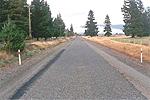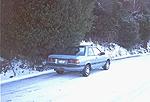Driving and Road Safety > Regional Road Information - Southland and Fiordland
Regional Road Information - Southland and Fiordland
 This information has been kindly supplied by the Land Transport New Zealand. For more information, please visit the Land Transport New Zealand website.
This information has been kindly supplied by the Land Transport New Zealand. For more information, please visit the Land Transport New Zealand website.
On This Page:
See Also:
| Regional Road Information |
| Welcome to Southland and Fiordland:
Within Southland you will experience many hill climbs that open out to a picturesque vista. Don’t let these views divert your attention from driving. This picture of the Carolyn hill near Lumsden opens to a magnificent view but the sharp corner ahead needs all your care and attention. If you wish to take a photograph remember to park your vehicle where it is safe to do so. Don’t park on or around a bend, in the middle of the road or where it is dangerous for you to walk or stand.
Gravel beware! Travelling around Southland and Fiordland you may occasionally encounter an unsealed road with loose stones on its surface, especially in areas far from the main towns, and in the Catlins (east coast) area.
These gravel roads are probably unlike those you have driven on at home so extra care is needed. Traveling on these roads can be like driving on ballbearings and offers a very low skid resistance. Reduce your speed and try not to brake or accelerate heavily. Drive in established tracks where the surface is harder but keep left at all times. When approaching an oncoming vehicle slow down further to allow it to pass. You will also need to take extra care in dry weather, as your visibility may be reduced by dust. Always stay back from a dust cloud caused by a vehicle in from of you.
Milford Sound Road: The Milford Road to Milford Sound from Te Anau offers the visitor views of lush native bush, beautiful rivers and waterfalls, gorges and spectacular mountainous ranges. However be aware that this road is also traveled by numerous other cars and buses. SPECIAL CARE IS NEEDED: navigating the many one-lane bridges, the ‘Homer Saddle’ with its tight twisting road, the Homer Tunnel and many narrow sharp bends. Keep the speed of your vehicle down and if you wish at any time to stop and take photographs, park as far to the left as possible, where your vehicle is easily seen and it is safe for you to walk of stand.
Southern Scenic Route: This is a popular drive through beautiful scenery on a par with anything in New Zealand. Winding around the hills and valleys along the Southern Scenic Route is a good alternative to the main highways. The road has numerous one-lane bridges which require particular care and attention. These are described below. The road also has many sharp bends and one section is still unsealed. You may be sharing the road with logging trucks as well as tourist buses. Keeping left is essential.
There are several rest areas along the route near to the points of interest. Look out for the blue signs showing a picnic table for directions. You will also need to take extra care in dry weather, as dust may obscure your view of the road ahead. Always stay back from a dust cloud.
You need to be aware that at certain times of the day you may be looking directly into the sun, especially when driving at sunrise or sunset, on uphill slopes and coming around bends. This can cause sunstrike. To minimize the hazards when sunstrike occurs you should make sure you always have a clean windscreen, inside and out, wear sunglasses and use your car’s sun visors. Be especially careful in winter, when sunstrike is more likely to occur.
The Catlins Road between Balclutha and Invercargill is a popular tourist route where you can enjoy sweeping coastline vistas, native flora and fauna and abundant wildlife. The yellow eyed penguin nests ashore in some parts of the Catlins and is one of the world’s most endangered species. In Southland we have many rare species of wildlife and your co-operation in preserving their habitats is appreciated. Photographing is allowed, but remember to keep your distance and park your vehicle where it is safe to do so. Do not park on or around a bend, in the middle of the road or where it is dangerous for you to walk or stand.
Wandering Livestock: Within the province of Southland there is extensive sheep, dairy and deer farming. When driving around the region you will need to watch out for wandering stock on the road or roadside. Stock signs, broken fences, open gates or droppings may indicate that there is stock wandering up ahead. If you encounter stock on the road or roadside SLOW DOWN immediately, pull over to the side of the road and be prepared to stop. Do not sound your horn or make a noise to frighten the animal/s and if a farmer is there follow his/her directions. If you see wandering stock on the road and no farmer present go to the nearest house and tell the occupant.
Secondary Roads – (unmarked road). Some roads in Southland are sealed, but are narrow and may have no markings to direct you. Always keep as close as possible to the left-hand side of the road to keep clear of oncoming traffic. These roads are sometimes bordered by gravel or an uneven surface. If your wheels encounter either of these surfaces do not panic, use your engine to SLOW DOWN: lightly apply your brake by tapping, firmly grip the steering wheel and drive in a straight line, gradually steering the vehicle back on to the sealed road.
One lane bridges: The sign in the photo above is shown on the approach to one-lane bridges. These are found throughout New Zealand, not just in Southland. Traffic from one direction must stop and allow other traffic to cross the bridge as it is not wide enough for vehicles to pass each other. Whichever direction you approach one of these bridges from, be prepared to stop to allow other vehicles to drive across.
|
| Winter Driving |
|
Winter driving conditions may be encountered in Otago and Southland any time between April and September, although the risk is higher between the months of June, July and August, creating road conditions that demand extra care and attention by drivers.
Here are a few simple rules that will make your journey safer:
- Your Trip: Check the road conditions ahead - choose safety over convenience to select your route. Keep your SPEED DOWN at all times
- Your Car: Check the brakes, wiperblades (make sure the windscreen is clean), battery tyre pressure and tread. Keep your SPEED DOWN at all times
- Yourself: Dress warm - carry warm clothing in case you get stuck or breakdown. And remember ... Keep your SPEED DOWN at all times
|
Many More Important Links









